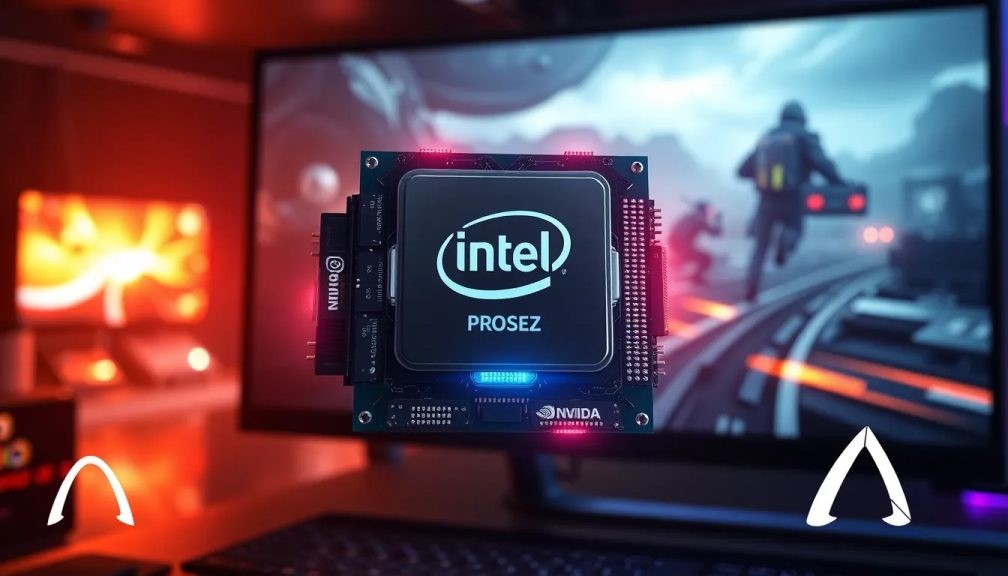Future Intel CPUs with Nvidia RTX iGPUs: Is Arc Finished?

In a game-changing move that has sent ripples through the tech industry, Nvidia has acquired a $5 billion stake in Intel, translating to about a 4.9% ownership of the venerable company. This strategic partnership sets the stage for collaboration in developing components tailored for both consumer and data center markets, notably focusing on x86 CPUs integrated with cutting-edge RTX GPU chiplets.
The implications of this partnership are profound. For Intel, this infusion of capital not only bolsters its financial standing but also grants access to some of the most coveted graphics technology available today. Conversely, Nvidia stands to gain a critical foothold in x86 manufacturing, an area where it has long been reliant on partnerships with other companies. This deal marks a significant shift in the competitive landscape of the semiconductor industry.
Nvidia's Position in the x86 Market
Historically, the x86 architecture has been dominated by AMD and Intel. This exclusivity has allowed both companies to create a synergistic relationship between their CPUs and GPUs, enhancing performance and efficiency. Until now, Nvidia has primarily operated within the Arm architecture but is now poised to leverage this new partnership to produce more competitive products in the x86 space.
- AMD and Intel: The only firms licensed to produce x86 processors.
- Graphics Integration: This partnership may lead to unprecedented integration of Nvidia’s GPUs with Intel’s CPUs.
- Market Opportunities: Both companies can now capitalize on the growing demand for high-performance computing solutions.
Future Developments in CPU and GPU Technology
Looking ahead, Intel has committed to creating custom x86 CPUs specifically for Nvidia. These CPUs will be integral to powering AI infrastructures and will soon feature systems on chips (SoCs) equipped with RTX GPU chiplets. This development is anticipated to revolutionize the computational capabilities available to consumers and enterprises alike.
As the market evolves, consumers can expect to see:
- Enhanced AI Capabilities: With tailored CPUs, applications in AI will benefit significantly.
- Improved Gaming Experience: The combination of Intel's CPUs with Nvidia's RTX technology promises to elevate gaming performance.
- New Product Lines: Expect innovative devices that integrate these advanced technologies, potentially offering unprecedented performance.
The Fate of Intel's Arc GPUs
As this partnership unfolds, questions arise regarding the future of Intel's Arc series of GPUs. Despite a promising start with the Xe2 architecture, exemplified by models like the Arc B580 and potential releases like the Arc B770, the long-term outlook is less certain. The significant investment in the partnership with Nvidia raises eyebrows about whether Intel will continue to allocate resources to the Arc project.
The recent developments suggest a pivotal moment for Intel's graphics division:
- Resource Allocation: With the RTX chiplets now available, Intel may prioritize these over the Arc series.
- Management Strategies: Intel's CEO, Lip-Bu Tan, has emphasized the need to improve profitability, which could impact future investments in Arc.
- Technological Advancements: Despite doubts, the advancements made in the Arc series could still hold merit in specific markets.
Current Performance and Future Prospects of Arc GPUs
The current performance of Intel's Arc GPUs has garnered a mix of praise and criticism. The Arc B580 has shown potential, particularly in gaming and productivity tasks, but challenges remain regarding driver support and software optimization. As Intel continues to develop its Xe3 architecture, expected to launch with its Panther Lake lineup, the future of Arc may hinge on its ability to adapt and compete in an increasingly crowded marketplace.
Intel's strategic direction in the GPU market could potentially lead to:
- Improved Driver Support: Addressing existing issues could enhance user experience significantly.
- Competitive Pricing: Pricing strategies may be adjusted to better position Arc against competitors.
- Continued Innovation: New architectures like Xe3 could reignite interest and investment in the Arc brand.
Implications for Consumers and the Industry
This partnership between Nvidia and Intel is set to reshape the consumer and data center markets profoundly. The fusion of Intel's CPU technology with Nvidia's GPU prowess could result in a new wave of products that outperform existing solutions. This evolution will not only benefit tech enthusiasts but also businesses seeking robust computing solutions for AI, machine learning, and gaming.
For those interested in a deeper dive into the potential outcomes of this partnership, consider watching this insightful video by Gamers Nexus that discusses the implications in detail:
Final Thoughts on the Future of Intel and Nvidia
While the future of Intel’s Arc GPUs remains uncertain in the wake of this significant partnership, the potential benefits of combined CPU and GPU technology are tantalizing. As consumers, we stand on the brink of a transformative era in computing power, with the promise of enhanced performance, efficiency, and innovation on the horizon.
To stay updated on developments in the tech world, including insights on AMD, Intel, and Nvidia, make sure to follow our coverage on Google News and explore our social media channels.




Leave a Reply